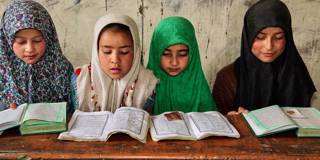Policymakers, education activists, and others who are worried about girls being left behind must look beyond school access. While relying on Islamic madrasas can increase the share of girls in classrooms, the substance of those girls’ educational experience matters, too.
KUALA LUMPUR – Ensuring inclusive, equitable, high-quality education for all is a major pillar of the United Nations Sustainable Development Goals. Three decades ago, fewer girls were in school than boys. Among those girls who were fortunate enough to be enrolled, the majority dropped out early. In many parts of the developing world, social norms and poverty combined to limit girls’ educational and social opportunities. However, improvements over the past 25 years in girls’ enrollment in primary and secondary education have been dramatic, significantly reducing educational gender disparities.
While girls still face extreme exclusion in Sub-Saharan African countries such as Ivory Coast, Guinea, and Togo, the gender enrollment gap has been closed or even reversed (with boys lagging girls) in developing Asia, often owing to government partnerships with religious and other private schools.
For example, during the 2000-2015 campaign for the Millennium Development Goals (the precursors to the SDGs), Islamic madrasas helped close the gender gap by widening school choice in Indonesia and Bangladesh. In Muslim-majority communities, religious and educational norms often conflict, with parents who want to educate their daughters facing opposition from local religious authorities. But madrasas reconcile these differences by educating unmarried girls without violating community norms, and they are often the only schools available in remote villages without public schools and where for-profit private institutions will not go.

KUALA LUMPUR – Ensuring inclusive, equitable, high-quality education for all is a major pillar of the United Nations Sustainable Development Goals. Three decades ago, fewer girls were in school than boys. Among those girls who were fortunate enough to be enrolled, the majority dropped out early. In many parts of the developing world, social norms and poverty combined to limit girls’ educational and social opportunities. However, improvements over the past 25 years in girls’ enrollment in primary and secondary education have been dramatic, significantly reducing educational gender disparities.
While girls still face extreme exclusion in Sub-Saharan African countries such as Ivory Coast, Guinea, and Togo, the gender enrollment gap has been closed or even reversed (with boys lagging girls) in developing Asia, often owing to government partnerships with religious and other private schools.
For example, during the 2000-2015 campaign for the Millennium Development Goals (the precursors to the SDGs), Islamic madrasas helped close the gender gap by widening school choice in Indonesia and Bangladesh. In Muslim-majority communities, religious and educational norms often conflict, with parents who want to educate their daughters facing opposition from local religious authorities. But madrasas reconcile these differences by educating unmarried girls without violating community norms, and they are often the only schools available in remote villages without public schools and where for-profit private institutions will not go.